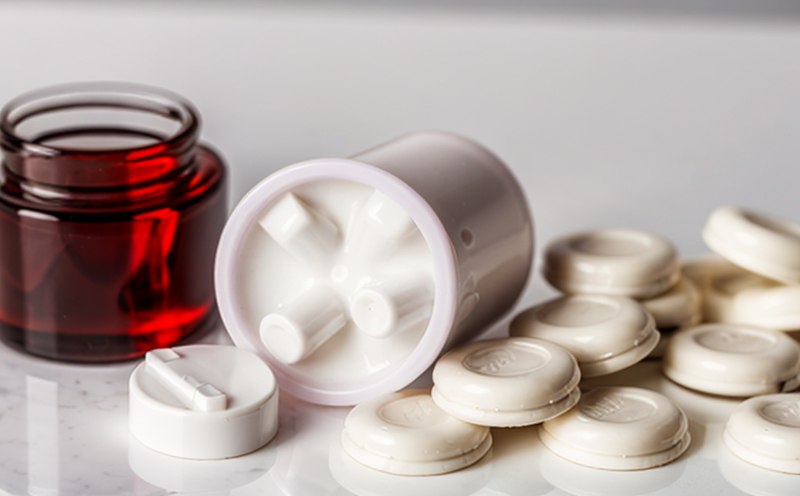USP Scored Tablet Split Uniformity Testing
The USP scored tablet split uniformity testing is a critical procedure aimed at ensuring that scored tablets meet the required quality standards and perform consistently across all units. This test is particularly important in pharmaceutical manufacturing as it directly impacts patient safety and therapeutic efficacy.
During this process, a scored tablet is divided into two equal halves to check for homogeneity of active ingredients between the two segments. The USP United States Pharmacopeia provides detailed guidelines on how these tests should be conducted. These standards are essential in ensuring that each part of a scored tablet contains an accurate and consistent amount of the active pharmaceutical ingredient.
The testing procedure involves precise splitting of the tablets, followed by the measurement of the weight and dissolution characteristics of both halves. The results obtained from this test help manufacturers comply with regulatory requirements and ensure product quality. By adhering to these standards, pharmaceutical companies can produce reliable medications that meet customer expectations and regulatory compliance.
One key aspect of scored tablet testing is the use of appropriate equipment such as a balance and dissolution apparatus. These tools are crucial in achieving accurate results. A high-precision digital balance ensures precise measurement of the split halves while a robust dissolution apparatus guarantees consistent and reliable performance under controlled conditions.
The acceptance criteria for USP scored tablet split uniformity testing include ensuring that both parts have similar weights within specified limits. Additionally, it is essential to confirm that there are no significant differences in the amount of active ingredient present in each segment. Compliance with these criteria not only enhances product quality but also builds trust among consumers and regulatory bodies.
In summary, USP scored tablet split uniformity testing plays a vital role in maintaining high standards within the pharmaceutical industry. By following this rigorous procedure, manufacturers can ensure that their products are safe, effective, and meet stringent quality expectations set forth by governing authorities like the FDA and EMA.
Industry Applications
The USP scored tablet split uniformity test finds extensive application across various sectors within the pharmaceutical industry. It is particularly useful for companies engaged in research and development (R&D) activities as it helps identify potential issues early in the product lifecycle.
Quality managers rely heavily on this testing method to monitor production processes closely, ensuring consistent quality throughout each batch run. Compliance officers use these tests regularly during audits conducted by regulatory bodies to verify adherence to established standards.
R&D engineers benefit from split uniformity tests because they provide valuable insights into formulation stability and potential modifications needed for improved performance. Procurement teams also play a crucial role in selecting suppliers who consistently meet such stringent quality benchmarks.
Overall, the USP scored tablet split uniformity test serves as an indispensable tool throughout all stages of pharmaceutical development – from initial concept through final product release.
Why Choose This Test
Selecting the right testing method is crucial when developing a new medication or improving existing products. Here are several compelling reasons why choosing USP scored tablet split uniformity testing can be beneficial:
Ensures Consistent Quality: By verifying that both halves of a scored tablet contain similar amounts of active ingredients, this test helps maintain consistent product quality.
Regulatory Compliance: Adherence to USP guidelines ensures compliance with stringent regulatory requirements set forth by agencies like the FDA and EMA.
Enhances Consumer Trust: High-quality products build trust among consumers, leading to increased market acceptance and loyalty.
Promotes Product Safety: Ensuring that each segment of a scored tablet has an accurate amount of active ingredients minimizes risks associated with improper dosing.
Aids in Formulation Optimization: Insights gained from these tests can guide R&D efforts towards optimizing formulations for better performance and stability.
Facilitates Efficient Manufacturing Processes: Regularly conducted split uniformity tests help manufacturers maintain efficient production lines by identifying and addressing any inconsistencies early on.
In conclusion, opting for USP scored tablet split uniformity testing offers numerous advantages that contribute significantly to overall product quality and safety. This makes it an indispensable tool in the pharmaceutical industry.
Environmental and Sustainability Contributions
The practice of conducting rigorous tests like USP scored tablet split uniformity contributes positively towards environmental sustainability efforts within the pharmaceutical sector. Here’s how:
Efficient Resource Use: By ensuring that each component of a scored tablet contains an accurate amount of active ingredients, this test reduces waste generated during manufacturing processes.
Reduced Energy Consumption: Consistent product quality allows for more efficient production lines, thereby reducing energy consumption associated with rework or scrap.
Promotes Recycling Initiatives: With improved product reliability and reduced defects, there is less need for disposal of faulty products, encouraging recycling practices instead.
Sustains Supplier Relationships: Consistent quality fosters long-term relationships between suppliers and manufacturers, promoting sustainable supply chains.
Incentivizes Innovation: The demand for high-quality products drives innovation in technology and processes, leading to more efficient and environmentally friendly manufacturing methods.
Enhances Brand Reputation: A commitment to quality not only enhances consumer trust but also strengthens brand reputation, encouraging further investment into sustainable practices.
In summary, the USP scored tablet split uniformity test plays a significant role in promoting environmental sustainability within the pharmaceutical industry. Its benefits extend beyond just product quality and safety, contributing positively towards overall eco-friendly initiatives.





